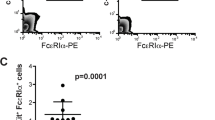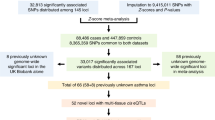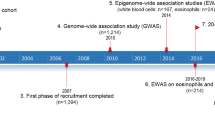Abstract
Allergic asthma is a genetically complex disease characterized by allergen-specific immunoglobulin (Ig)E, eosinophilic inflammation of the lungs and airway hyper-responsiveness to bronchospasmogenic stimuli. In this study, we compared 13 recombinant congenic (RC) mouse strains in an ovalbumin model of allergic asthma. Different intensities and types of responses are observed throughout the RC strains. Intensities range from resistance to asthma in CcS05, to a very severe bronchoconstrictive reaction upon methacholine challenge for the parental STS strain. All strains show a ‘modified’ Th2 response except CcS14, which shows a ‘true’ Th2 response. When data from all strains are pooled, airway reactivity shows significant correlations with the serum Ig levels and the levels of interleukin (IL)-4, IL-5 and IL-13 in the broncho-alveolar lavage (BAL), at low dosage of methacholine (below 25 mg/ml), whereas at high dosage airway reactivity only correlates with BAL neutrophil levels. This indicates that at least two different mechanisms are involved in the airway reactivity to methacholine. None of these correlations can be found in every individual strain, which demonstrates that the asthma traits in this mouse model are genetically dissociated and that the loci can be genetically mapped.
This is a preview of subscription content, access via your institution
Access options
Subscribe to this journal
Receive 6 digital issues and online access to articles
$119.00 per year
only $19.83 per issue
Buy this article
- Purchase on Springer Link
- Instant access to full article PDF
Prices may be subject to local taxes which are calculated during checkout
Similar content being viewed by others
References
Daniels SE, Bhattacharrya S, James A, Leaves NI, Young A, Hill MR et al. A genome-wide search for quantitative trait loci underlying asthma. Nature 1996; 383: 247–250.
Cookson WO, Sharp PA, Faux JA, Hopkin JM . Linkage between immunoglobulin E responses underlying asthma and rhinitis and chromosome 11q. Lancet 1989; 1: 1292–1295.
Barnes KC, Marsh DG . The genetics and complexity of allergy and asthma. Immunol Today 1998; 19: 325–332.
Marsh DG, Neely JD, Breazeale DR, Ghosh B, Freidhoff LR, Ehrlich-Kautzky E et al. Linkage analysis of IL4 and other chromosome 5q31.1 markers and total serum immunoglobulin E concentrations. Science 1994; 264: 1152–1156.
Nickel R, Wahn U, Hizawa N, Maestri N, Duffy DL, Barnes KC et al. Evidence for linkage of chromosome 12q15-q24.1 markers to high total serum IgE concentrations in children of the German Multicenter Allergy Study. Genomics 1997; 46: 159–162.
Postma DS, Bleecker ER, Amelung PJ, Holroyd KJ, Xu J, Panhuysen CI et al. Genetic susceptibility to asthma – bronchial hyperresponsiveness coinherited with a major gene for atopy. N Engl J Med 1995; 333: 894–900.
Hurme M, Pessi T, Karjalainen J . Genetics of inflammation and atopy. Ann Med 2003; 35: 256–258.
Jongepier H, Boezen HM, Dijkstra A, Howard TD, Vonk JM, Koppelman GH et al. Polymorphisms of the ADAM33 gene are associated with accelerated lung function decline in asthma. Clin Exp Allergy 2004; 34: 757–760.
Howard TD, Postma DS, Jongepier H, Moore WC, Koppelman GH, Zheng SL et al. Association of a disintegrin and metalloprotease 33 (ADAM33) gene with asthma in ethnically diverse populations. J Allergy Clin Immunol 2003; 112: 717–722.
Lee JH, Park HS, Park SW, Jang AS, Uh ST, Rhim T et al. ADAM33 polymorphism: association with bronchial hyper-responsiveness in Korean asthmatics. Clin Exp Allergy 2004; 34: 860–865.
Allen M, Heinzmann A, Noguchi E, Abecasis G, Broxholme J, Ponting CP et al. Positional cloning of a novel gene influencing asthma from Chromosome 2q14. Nat Genet 2003; 35: 258–263.
Zhang Y, Leaves NI, Anderson GG, Ponting CP, Broxholme J, Holt R et al. Positional cloning of a quantitative trait locus on chromosome 13q14 that influences immunoglobulin E levels and asthma. Nat Genet 2003; 34: 181–186.
Laitinen T, Polvi A, Rydman P, Vendelin J, Pulkkinen V, Salmikangas P et al. Characterization of a common susceptibility locus for asthma-related traits. Science 2004; 304: 300–304.
Kabesch M, Carr D, Weiland SK, von ME . Association between polymorphisms in serine protease inhibitor, kazal type 5 and asthma phenotypes in a large German population sample. Clin Exp Allergy 2004; 34: 340–345.
Lind DL, Choudhry S, Ung N, Ziv E, Avila PC, Salari K et al. ADAM33 is not associated with asthma in Puerto Rican or Mexican populations. Am J Respir Crit Care Med 2003; 168: 1312–1316.
Jongepier H, Koppelman GH, Nolte IM, Bruinenberg M, Bleecker ER, Meyers DA et al. Polymorphisms in SPINK5 are not associated with asthma in a Dutch population. J Allergy Clin Immunol 2005; 115: 486–492.
Badalova J, Svobodova M, Havelkova H, Vladimirov V, Vojtiskova J, Engova J et al. Separation and mapping of multiple genes that control IgE level in Leishmania major infected mice. Genes Immun 2002; 3: 187–195.
Demant P . Cancer susceptibility in the mouse: genetics, biology and implications for human cancer. Nat Rev Genet 2003; 4: 721–734.
Lipoldova M, Svobodova M, Havelkova H, Krulova M, Badalova J, Nohynkova E et al. Mouse genetic model for clinical and immunological heterogeneity of leishmaniasis. Immunogenetics 2002; 54: 174–183.
Kosarova M, Havelkova H, Krulova M, Demant P, Lipoldova M . The production of two Th2 cytokines, interleukin-4 and interleukin-10, is controlled independently by locus Cypr1 and by loci Cypr2 and Cypr3, respectively. Immunogenetics 1999; 49: 134–141.
Havelkova H, Kosarova M, Krulova M, Holan V, Demant P, Lipoldova M . T-cell proliferative response is controlled by locus Tria3 on mouse chromosome 17. Immunogenetics 1999; 49: 235–237.
Lipoldova M, Svobodova M, Krulova M, Havelkova H, Badalova J, Nohynkova E et al. Susceptibility to Leishmania major infection in mice: multiple loci and heterogeneity of immunopathological phenotypes. Genes Immun 2000; 1: 200–206.
Demant P, Lipoldova M, Svobodova M . Resistance to Leishmania major in mice. Science 1996; 274: 1392–1393.
Kramnik I, Demant P, Bloom BB . Susceptibility to tuberculosis as a complex genetic trait: analysis using recombinant congenic strains of mice. Novartis Found Symp 1998; 217: 120–131.
Kramnik I, Dietrich WF, Demant P, Bloom BR . Genetic control of resistance to experimental infection with virulent Mycobacterium tuberculosis. Proc Natl Acad Sci USA 2000; 97: 8560–8565.
Groot PC, Moen CJ, Dietrich W, Stoye JP, Lander ES, Demant P . The recombinant congenic strains for analysis of multigenic traits: genetic composition. FASEB J 1992; 6: 2826–2835.
Vladimirov V, Badalova J, Svobodova M, Havelkova H, Hart AA, Blazkova H et al. Different genetic control of cutaneous and visceral disease after Leishmania major infection in mice. Infect Immun 2003; 71: 2041–2046.
Moen CJ, van der Valk MA, Snoek M, van Zutphen BF, von Deimling O, Hart AA et al. The recombinant congenic strains–a novel genetic tool applied to the study of colon tumor development in the mouse. Mamm Genome 1991; 1: 217–227.
Moen CJ, van der Valk MA, Bird RP, Hart AA, Demant P . Different genetic susceptibility to aberrant crypts and colon adenomas in mice. Cancer Res 1996; 56: 2382–2386.
Fijneman RJ, de Vries SS, Jansen RC, Demant P . Complex interactions of new quantitative trait loci, Sluc1, Sluc2, Sluc3, and Sluc4, that influence the susceptibility to lung cancer in the mouse. Nat Genet 1996; 14: 465–467.
Fijneman RJ, van der Valk MA, Demant P . Genetics of quantitative and qualitative aspects of lung tumorigenesis in the mouse: multiple interacting susceptibility to lung cancer (Sluc) genes with large effects. Exp Lung Res 1998; 24: 419–436.
Tripodis N, Demant P . Genetic analysis of three-dimensional shape of mouse lung tumors reveals eight lung tumor shape-determining (Ltsd) loci that are associated with tumor heterogeneity and symmetry. Cancer Res 2003; 63: 125–131.
Stassen AP, Groot PC, Eppig JT, Demant P . Genetic composition of the recombinant congenic strains. Mamm Genome 1996; 7: 55–58.
Deurloo DT, van Esch BC, Hofstra CL, Nijkamp FP, Van Oosterhout AJ . CTLA4-IgG reverses asthma manifestations in a mild but not in a more ‘severe’ ongoing murine model. Am J Respir Cell Mol Biol 2001; 25: 751–760.
Platts-Mills TA, Woodfolk JA, Erwin EA, Aalberse R . Mechanisms of tolerance to inhalant allergens: the relevance of a modified Th2 response to allergens from domestic animals. Springer Semin Immunopathol 2004; 25: 271–279.
Whitehead GS, Walker JK, Berman KG, Foster WM, Schwartz DA . Allergen-induced airway disease is mouse strain dependent. Am J Physiol Lung Cell Mol Physiol 2003; 285: 32–42.
Walter DM, McIntire JJ, Berry G, McKenzie AN, Donaldson DD, Dekruyff RH et al. Critical role for IL-13 in the development of allergen-induced airway hyperreactivity. J Immunol 2001; 167: 4668–4675.
Howard TD, Whittaker PA, Zaiman AL, Koppelman GH, Xu J, Hanley MT et al. Identification and association of polymorphisms in the interleukin-13 gene with asthma and atopy in a Dutch population. Am J Respir Cell Mol Biol 2001; 25: 377–384.
Vladich FD, Brazille SM, Stern D, Peck ML, Ghittoni R, Vercelli D . IL-13 R130Q, a common variant associated with allergy and asthma, enhances effector mechanisms essential for human allergic inflammation. J Clin Invest 2005; 115: 747–754.
Justice JP, Shibata Y, Sur S, Mustafa J, Fan M, Van Scott MR . IL-10 gene knockout attenuates allergen-induced airway hyperresponsiveness in C57BL/6 mice. Am J Physiol Lung Cell Mol Physiol 2001; 280: L363–L368.
Makela MJ, Kanehiro A, Borish L, Dakhama A, Loader J, Joetham A et al. IL-10 is necessary for the expression of airway hyperresponsiveness but not pulmonary inflammation after allergic sensitization. Proc Natl Acad Sci USA 2000; 97: 6007–6012.
Zhang Y, Lefort J, Kearsey V, Lapa e Silva JR, Cookson WO, Vargaftig BB . A genome-wide screen for asthma-associated quantitative trait loci in a mouse model of allergic asthma. Hum Mol Genet 1999; 8: 601–605.
Chatterjee R, Batra J, Kumar A, Mabalirajan U, Nahid S, Niphadkar PV et al. Interleukin-10 promoter polymorphisms and atopic asthma in North Indians. Clin Exp Allergy 2005; 35: 914–919.
Wynn TA . IL-13 effector functions. Annu Rev Immunol 2003; 21: 425–456.
Nicolaides NC, Holroyd KJ, Ewart SL, Eleff SM, Kiser MB, Dragwa CR et al. Interleukin 9: a candidate gene for asthma. Proc Natl Acad Sci USA 1997; 94: 13175–13180.
Havelkova H, Kosarova M, Krulova M, Demant P, Lipoldova M . T-cell proliferative response is controlled by loci Tria4 and Tria5 on mouse chromosomes 7 and 9. Mamm Genome 1999; 10: 670–674.
Nicklas W, Baneux P, Boot R, Decelle T, Deeny AA, Fumanelli M et al. Recommendations for the health monitoring of rodent and rabbit colonies in breeding and experimental units. Lab Anim 2002; 36: 20–42.
Vissers JL, van Esch BC, Hofman GA, Kapsenberg ML, Weller FR, Van Oosterhout AJ . Allergen immunotherapy induces a suppressive memory response mediated by IL-10 in a mouse asthma model. J Allergy Clin Immunol 2004; 113: 1204–1210.
Van Oosterhout AJ, Van Esch B, Hofman G, Hofstra CL, Van Ark I, Nijkamp FP et al. Allergen immunotherapy inhibits airway eosinophilia and hyperresponsiveness associated with decreased IL-4 production by lymphocytes in a murine model of allergic asthma. Am J Respir Cell Mol Biol 1998; 19: 622–628.
Acknowledgements
We thank Professor Dr DS Postma and Dr GH Koppelman for their critical reviews of the manuscript and Dr HM Boezen for her help on the statistics. This work is supported by research grants (AF99.23 and AF03.55) of the Dutch Asthma Foundation (NAF).
Author information
Authors and Affiliations
Corresponding author
Rights and permissions
About this article
Cite this article
Piavaux, B., Jeurink, P., Groot, P. et al. Mouse genetic model for antigen-induced airway manifestations of asthma. Genes Immun 8, 28–34 (2007). https://doi.org/10.1038/sj.gene.6364354
Received:
Accepted:
Published:
Issue Date:
DOI: https://doi.org/10.1038/sj.gene.6364354



